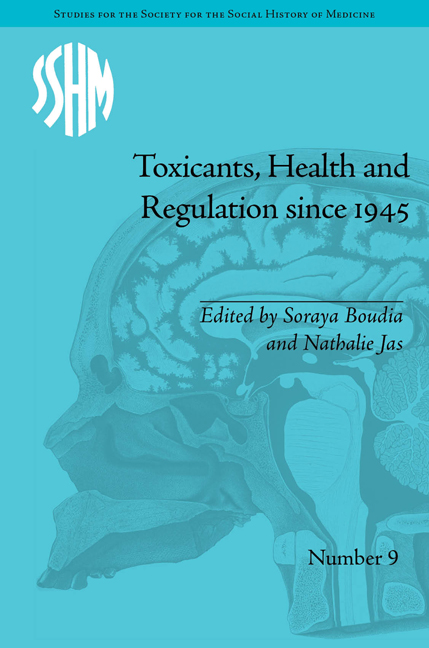Book contents
- Frontmatter
- Contents
- Acknowledgements
- List of Figures and Tables
- List of Contributors
- Introduction
- 1 The Cold War Over the Worker's Body: Cross-National Clashes Over Maximum Allowable Concentrations in the Post-World War II Era
- 2 Adapting To ‘Reality’: The Emergence of an International Expertise On Food Additives and Contaminants in the 1950s and Early 1960s
- 3 From Threshold to Risk: Exposure to Low Doses of Radiation and its Effects On Toxicants Regulation
- 4 ‘License To Expose’? Occupational Exposure Limits, Scientific Expertise and State in Contemporary France
- 5 Chemical Infrastructures of the St Clair River
- 6 Managing an Everlastingly Polluted World: Food Policies And Community Health Actions in the French West Indies
- 7 Chernobyl Empowerment? Exporting ‘Participatory Governance’ to Contaminated Territories
- Notes
- Index
6 - Managing an Everlastingly Polluted World: Food Policies And Community Health Actions in the French West Indies
- Frontmatter
- Contents
- Acknowledgements
- List of Figures and Tables
- List of Contributors
- Introduction
- 1 The Cold War Over the Worker's Body: Cross-National Clashes Over Maximum Allowable Concentrations in the Post-World War II Era
- 2 Adapting To ‘Reality’: The Emergence of an International Expertise On Food Additives and Contaminants in the 1950s and Early 1960s
- 3 From Threshold to Risk: Exposure to Low Doses of Radiation and its Effects On Toxicants Regulation
- 4 ‘License To Expose’? Occupational Exposure Limits, Scientific Expertise and State in Contemporary France
- 5 Chemical Infrastructures of the St Clair River
- 6 Managing an Everlastingly Polluted World: Food Policies And Community Health Actions in the French West Indies
- 7 Chernobyl Empowerment? Exporting ‘Participatory Governance’ to Contaminated Territories
- Notes
- Index
Summary
INRA thus feels that whilst soil pollution by HCH will no longer be an issue in 2010, it will nevertheless take several centuries for drainage waters to slowly cleanse the earth and put an end to chlordecone pollution.
Introduction
What if policymakers took the fact that we live in a permanently polluted world seriously, rather than considering pollution to be harmless, negligible or easily manageable? What would be the consequences of such an attitude? Since the end of the 1990s, the rediscovery of chlordecone in the surface waters of the French West Indies has given us a small laboratory with which to answer these questions by looking at how authorities have attempted to ensure that people live in safety. Chlordecone is a pesticide which until 1993 was used to fight banana weevils; it remains almost permanently in the soil and is only very slowly drained away. Whilst environmental pollution is not disputed as and when it is discovered, the issue of the health consequences of such pollution continues to be hotly debated. The toxicity of high doses of chlordecone is well established, due to the massive production of epidemiological and toxicological knowledge following the Hopewell factory disaster in 1975, leading to chlordecone being banned in the United States. The West Indian case raises the issue of its possible harmful effects (cancers, fertility problems) at low doses, following exposure over a very long period.
- Type
- Chapter
- Information
- Toxicants, Health and Regulation since 1945 , pp. 117 - 134Publisher: Pickering & ChattoFirst published in: 2014

